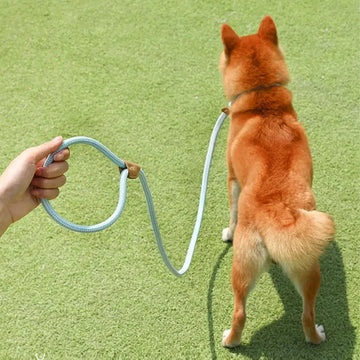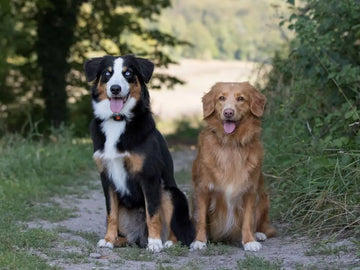Training your dog to walk on a leash is one of the most essential and rewarding skills both you and your pet can master. It’s not just about keeping your dog safe but also ensuring that every walk is an enjoyable experience for both of you. But to make this process smoother, the right dog supplies, especially dog leashes, are vital. These tools serve as your foundation for successful leash training, ensuring both comfort and control.
In this comprehensive guide, we will take you through the step-by-step process of leash training while emphasizing the importance of choosing the right equipment, such as the dog collar, as well as how to address common issues faced during training.
Why Leash Training is Crucial for You and Your Dog
Whether you're taking your dog for a quick stroll around the block or going on a hiking adventure, a good leash training routine ensures that your dog behaves and stays safe. Walking a dog without training often results in unwanted behaviors like pulling, lunging, or running away, which could be dangerous both for your pet and others.
Leash training gives you control, promotes exercise, and helps with overall behavior control. When paired with a comfortable collar and leash, it turns walks into fun and bonding experiences rather than stressful confrontations.
1. Choosing the Right Dog Collar and Leash
Before diving into training, it’s essential to start with the right dog supplies. Using poorly designed or ill-fitting equipment can result in discomfort for your dog and hinder the training process. For effective leash training, you’ll want a collar and leash combination that provides both comfort and control.
The adjustable slip rope leash and collar combo available at Florayy provides just that. Made from durable nylon, the slip rope collar is perfect for medium to large dogs, offering both flexibility and security. The adjustable loop collar ensures it can fit different neck sizes, ensuring that the collar isn’t too tight or too loose—key for comfort during training sessions.
Why Nylon Leash and Collar Are Best for Training
Nylon is a top choice when it comes to dog collars and leashes for training. It is durable, lightweight, and water-resistant, which makes it perfect for both everyday walks and more strenuous outdoor activities. The slip rope design also helps prevent pulling by applying even pressure around the neck without causing harm to your dog.
2. Preparing Your Dog for Leash Training
Before you start training, it’s crucial to ensure your dog is comfortable with wearing the dog collar and having the leash attached. If your dog is not accustomed to wearing a collar or harness, suddenly attaching a leash can be overwhelming for them.
Step 1: Introducing the Collar and Leash
Start by allowing your dog to sniff and explore the leash and collar. Don’t rush into attaching it immediately; instead, let them get used to the feeling of the collar around their neck. Use treats and praise to create a positive association with the collar. Once your dog shows signs of comfort with the collar, attach the leash but let them drag it around the house for a few minutes. Keep the experience light and stress-free, giving your dog time to adjust.
Step 2: Positive Reinforcement
Using treats and praise consistently is key to creating a positive connection with leash training. Reward your dog whenever they show calm behavior while wearing the collar and leash. This method helps your dog understand that being leashed is a good thing, not a punishment.
3. Basic Leash Walking Techniques
Once your dog is comfortable wearing the leash, it’s time to introduce them to walking on the leash. Start in a low-distraction environment, like inside your home or your backyard. This way, your dog can focus on you and not get distracted by external factors.
Start Slow
Hold the leash loosely in your hand, making sure there’s a little slack. Begin walking and encourage your dog to follow you. It’s important to let your dog set the pace at first, allowing them to get used to walking with a leash without feeling pressured.
Use Clear Commands
Establish commands like “heel” or “let’s go” that signal to your dog when it’s time to start walking. Consistency is key in this phase. You’ll also want to reward your dog whenever they walk by your side calmly, reinforcing the behavior you want.
4. Dealing with Leash Pulling
One of the most common challenges in leash training is dealing with leash pulling. Dogs instinctively want to move towards things that interest them, so pulling on the leash can become a habit. Here’s how to correct it:
The Stop-and-Go Method
When your dog pulls on the leash, immediately stop walking. Stand still and wait for them to return to your side or stop pulling. Only when your dog is calm should you continue walking. This teaches your dog that pulling doesn’t get them anywhere and that calm behavior leads to rewards.
Reward Calm Behavior
As soon as your dog starts walking calmly beside you, reward them with a treat and praise. Over time, your dog will associate walking at your side with positive outcomes, making them less likely to pull in the future.
5. Gradually Increasing Difficulty
After successfully training your dog to walk calmly indoors or in your yard, it’s time to move to more challenging environments. Begin by walking on quieter streets or parks where there are fewer distractions.
Introducing Distractions
As your dog gets better at walking on the leash in a calm environment, start increasing distractions. This could mean walking near other dogs, cars, or people. The goal here is to teach your dog to focus on you even in the presence of distractions. Continue to reward them for calm behavior, ensuring they stay focused and don’t revert to pulling or tugging.
Increasing Walk Duration
Increase the length of your walks gradually. Start with shorter sessions and slowly build up to longer walks. This will help your dog build endurance and prevent them from becoming overwhelmed or fatigued.
6. Overcoming Setbacks
Leash training is a process, and like any other type of training, it comes with its fair share of challenges. It’s essential to stay patient and consistent, especially when faced with setbacks. If your dog continues to pull or refuses to walk, revisit some of the earlier training steps.
Addressing Leash Anxiety
Some dogs may experience anxiety when attached to a leash, especially if they’ve had a negative experience in the past. If this is the case, it’s essential to go back to basics and work at your dog’s pace. Slowly reintroduce the leash in a positive, stress-free manner. You may also want to consider using a more comfortable, padded harness to reduce pressure on their neck.
Consistency is Key
One of the most important things to remember in leash training is that consistency is essential. Regular training sessions, even if brief, are much more effective than occasional long sessions. Practice daily and make it a fun experience for your dog by incorporating play or rewards during the walks.
7. Advanced Leash Training Techniques
Once your dog has mastered basic leash training, you can begin exploring more advanced techniques, such as off-leash walking or using longer leashes.
Using a Long Leash
If you’re interested in giving your dog more freedom during walks, consider using a longer leash. This allows your dog to explore a larger area while still being under control. However, it’s essential to practice recall commands before transitioning to a long leash, as you’ll need to maintain control if needed.
Off-Leash Walking
If you’re ready to let your dog off-leash, ensure that they have mastered basic commands such as “stay,” “come,” and “heel.” Begin in a secure, enclosed area before transitioning to public spaces. Always carry a leash with you in case you need to regain control.
Conclusion: The Importance of Choosing the Right Dog Supplies
The key to successful leash training lies in having the right dog supplies, especially a good dog collar and best dog leash. A well-fitted collar and sturdy leash, like the adjustable slip rope collar and nylon leash available at Florayy, are crucial for both safety and comfort during training. Remember, consistency, patience, and positive reinforcement are essential to making leash walks enjoyable for both you and your dog.
By following these steps, you’ll build a strong bond with your dog and enjoy every walk together. So, gear up with the best equipment, stick to a regular training schedule, and enjoy the journey of transforming your walks into a delightful experience!
Q: What is the best leash and collar combination for dog training?
A: A flat collar with a sturdy leash works well for most dogs.
Q: Should I use a choke collar for training?
A: It’s not recommended; use more humane options like a flat collar or harness.
Q: How do I choose the right size collar for my dog?
A: Measure your dog’s neck and add a couple of inches for comfort.
Q: Can I use a retractable leash for training?
A: No, a standard leash is better for control during training.
Q: Can a harness be used for training?
A: Yes, a harness provides better control, especially for dogs that pull.
Q: What type of collar is best for puppies?
A: A flat collar is usually the best choice for puppies, as it’s comfortable and adjustable.
Q: How tight should a dog collar be?
A: The collar should be snug but allow you to fit two fingers comfortably between the collar and your dog’s neck.
Q: When should I start using a leash for training?
A: Start using a leash as early as possible, even during puppyhood, to help your dog get used to walking on it.
Q: How long should my dog’s training sessions be?
A: Keep training sessions short, around 10-15 minutes, to maintain your dog's focus and prevent frustration.










